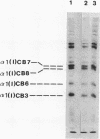Abstract
We analyzed tissue and cells from a stationary and a rapidly growing hyperplastic callus from a patient with osteogenesis imperfecta (OI) type IV and compared the results with those of compact bone and skin fibroblasts of an age-matched control. Collagen and protein contents per cell were low in the callus tissues and collagen I and III were overmodified as evidenced by an elevated level of hydroxylysine. The degree of lysyl hydroxylation was highest in those regions that appeared most immature by histological examination. Lysyl hydroxylation approached normal levels in collagen from the stationary callus and from the center of the growing callus. Overmodification of collagen was not seen in compact bone or cell cultures (neither skin fibroblasts nor callus cells) from the patient. Elevation of hydroxylysine in collagen from OI patients is generally attributed to mutations that delay triple helix formation. Our observations suggest that the varying degree of collagen modifications may occur in consequence of regulatory mechanisms during bone development and tissue repair. These mechanisms may be defective in some patients with OI as seen in this case with hyperplastic callus formation.
Full text
PDF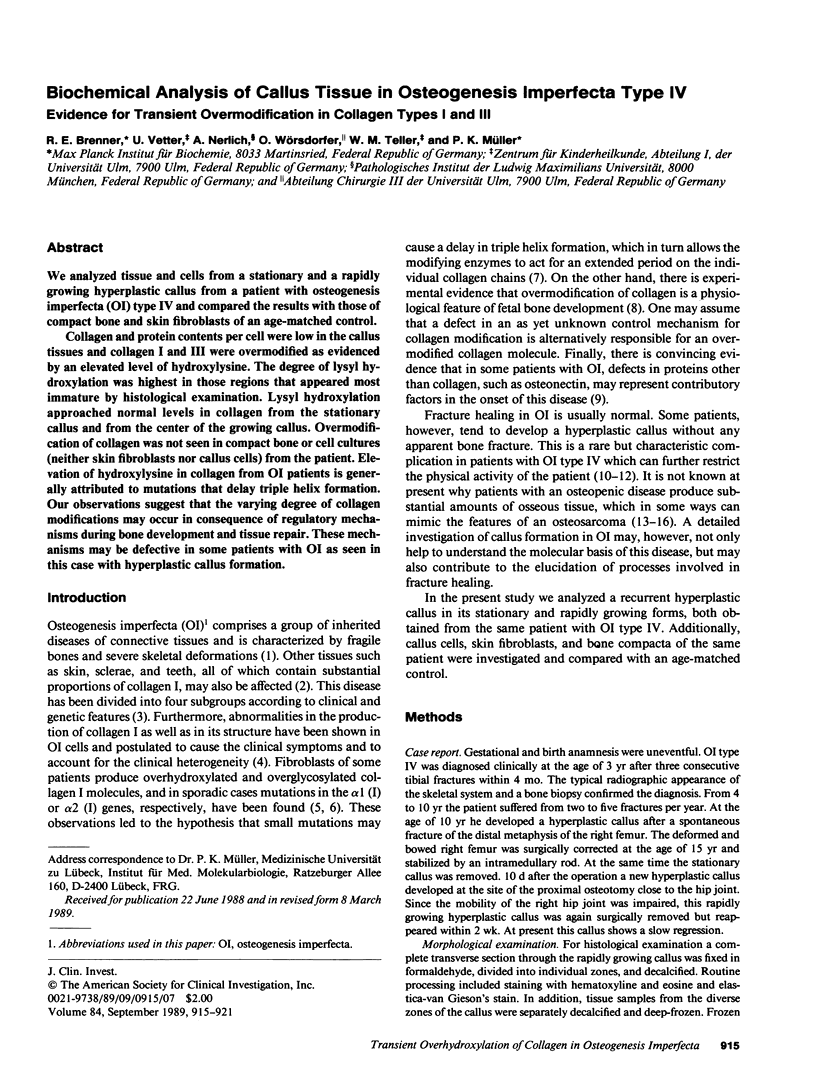
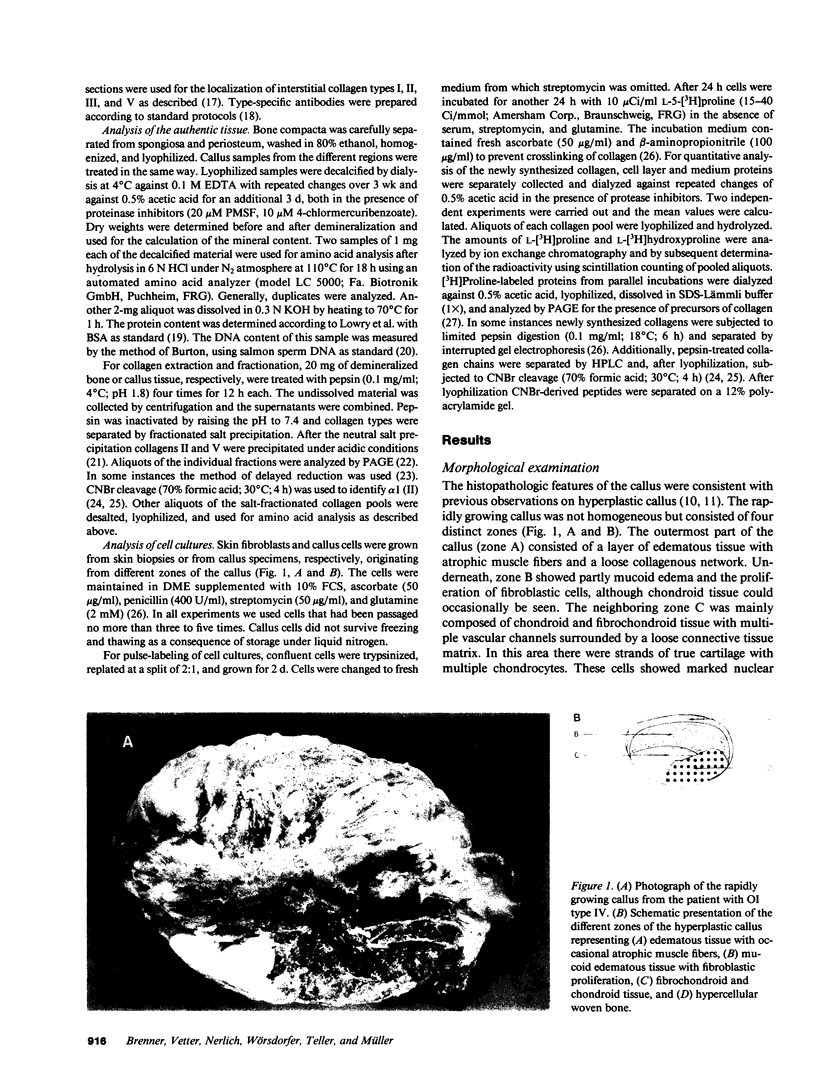
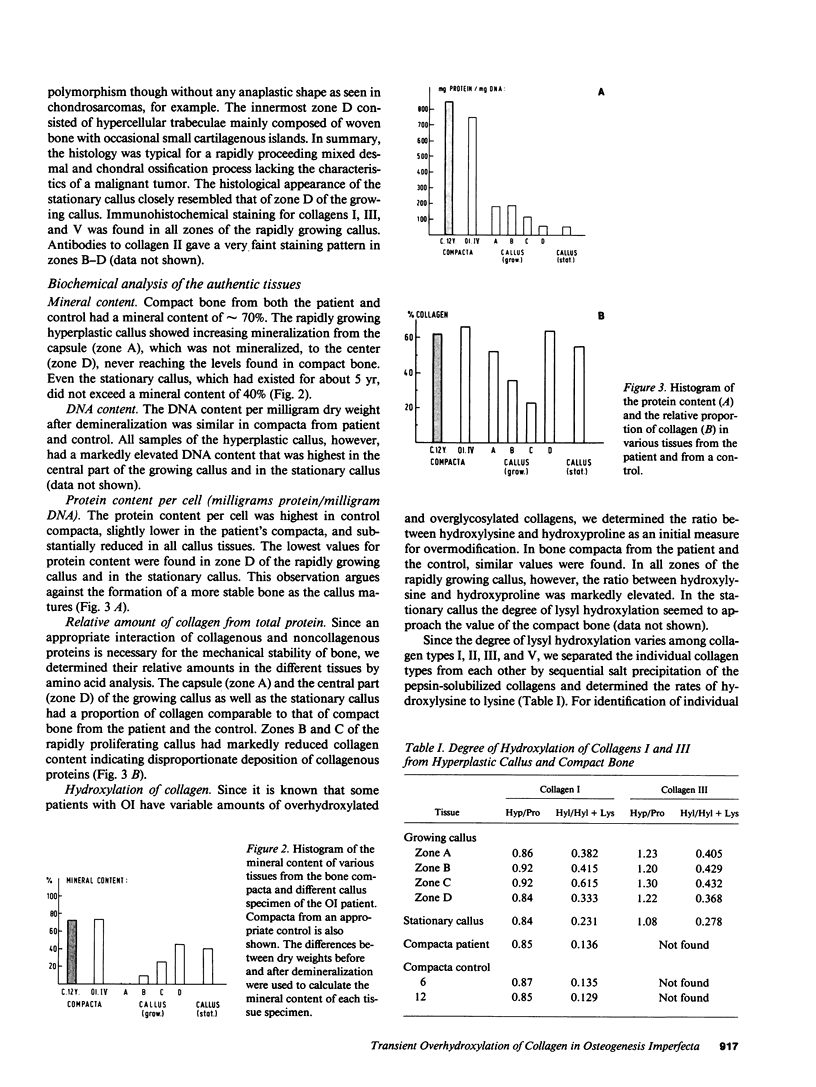
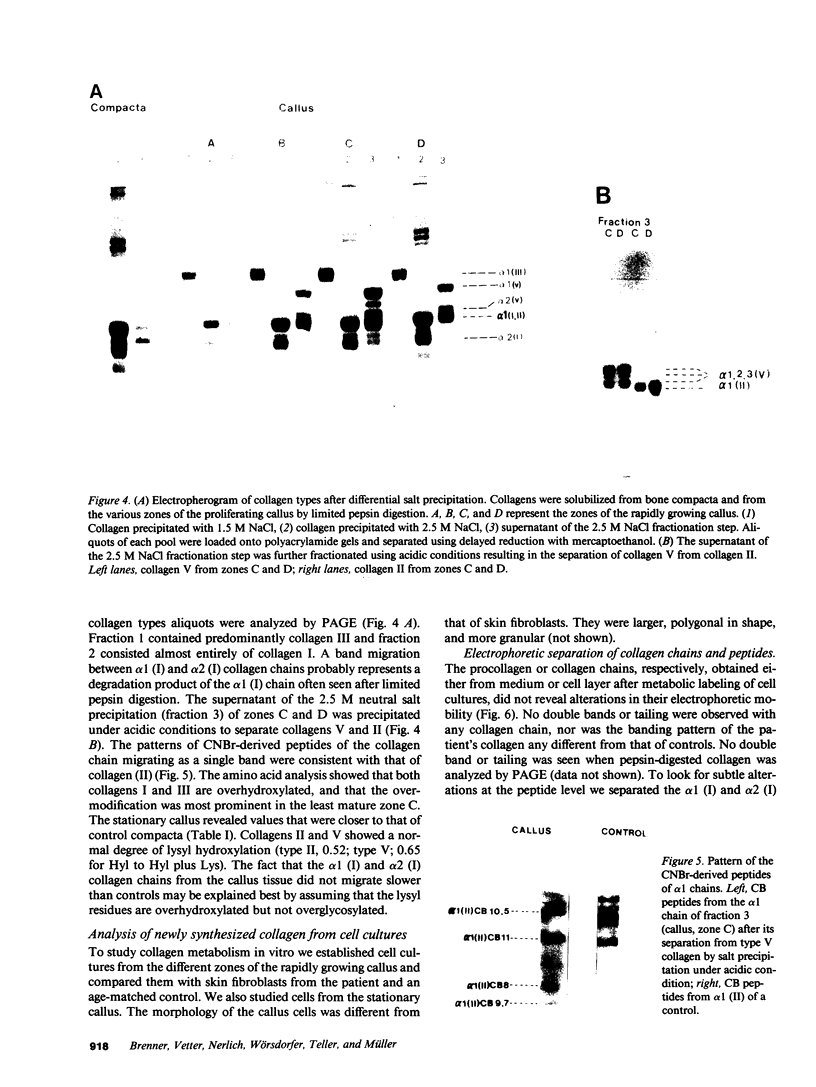
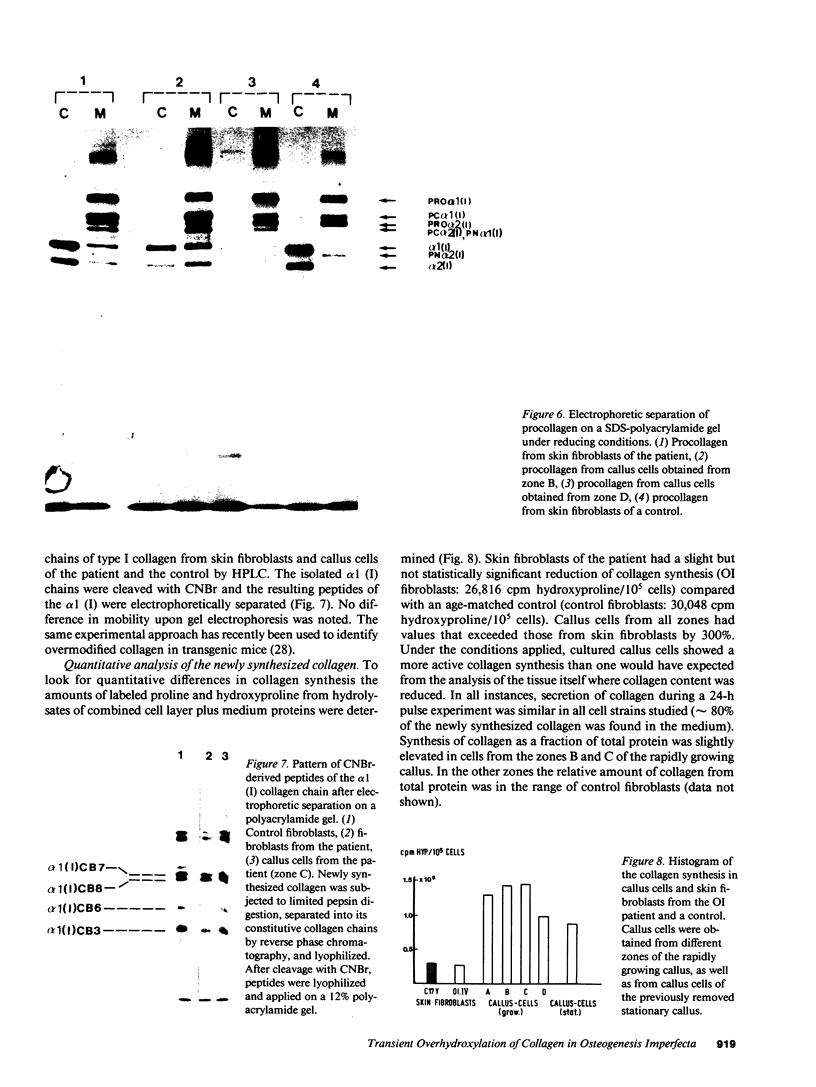
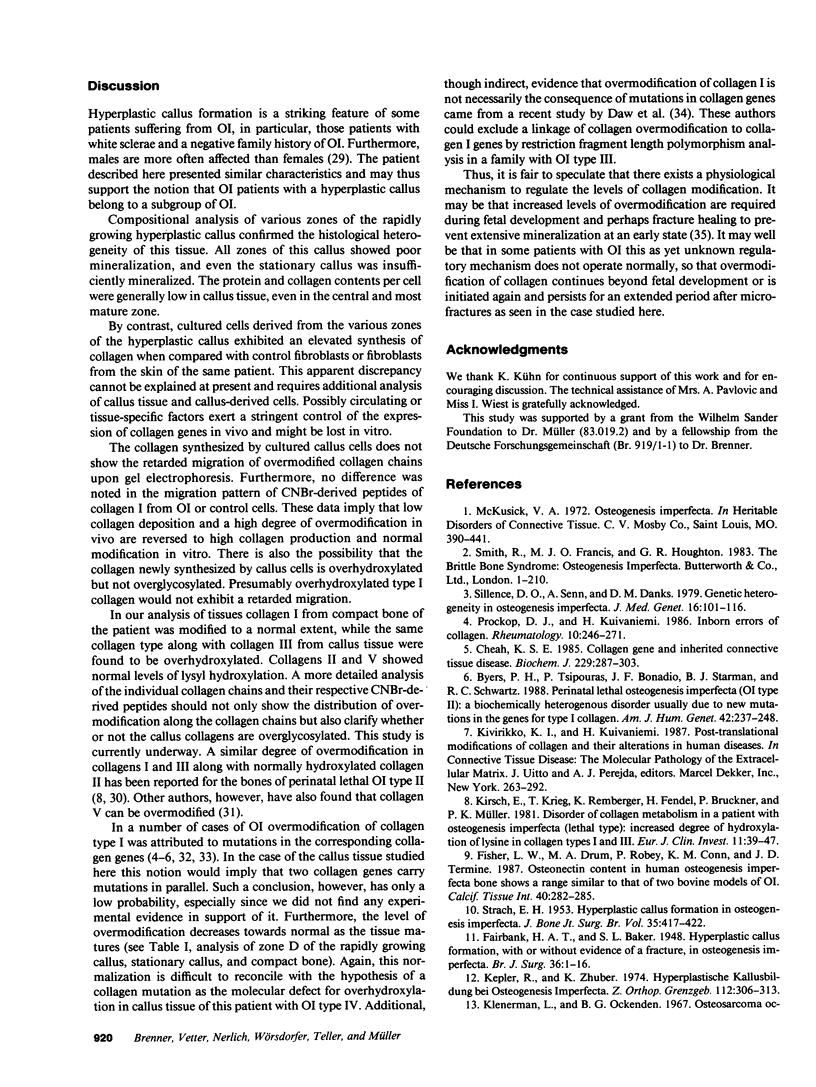
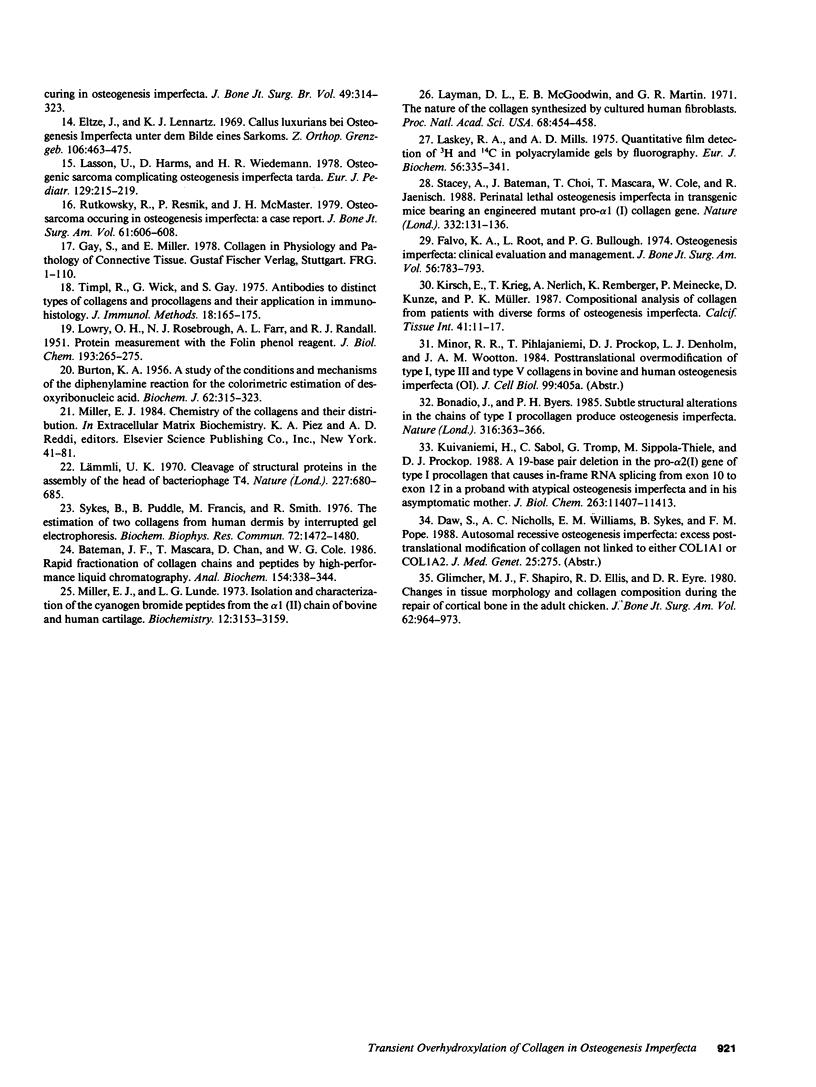
Images in this article
Selected References
These references are in PubMed. This may not be the complete list of references from this article.
- BURTON K. A study of the conditions and mechanism of the diphenylamine reaction for the colorimetric estimation of deoxyribonucleic acid. Biochem J. 1956 Feb;62(2):315–323. doi: 10.1042/bj0620315. [DOI] [PMC free article] [PubMed] [Google Scholar]
- Bateman J. F., Mascara T., Chan D., Cole W. G. Rapid fractionation of collagen chains and peptides by high-performance liquid chromatography. Anal Biochem. 1986 Apr;154(1):338–344. doi: 10.1016/0003-2697(86)90534-8. [DOI] [PubMed] [Google Scholar]
- Bonadio J., Byers P. H. Subtle structural alterations in the chains of type I procollagen produce osteogenesis imperfecta type II. Nature. 1985 Jul 25;316(6026):363–366. doi: 10.1038/316363a0. [DOI] [PubMed] [Google Scholar]
- Byers P. H., Tsipouras P., Bonadio J. F., Starman B. J., Schwartz R. C. Perinatal lethal osteogenesis imperfecta (OI type II): a biochemically heterogeneous disorder usually due to new mutations in the genes for type I collagen. Am J Hum Genet. 1988 Feb;42(2):237–248. [PMC free article] [PubMed] [Google Scholar]
- Cheah K. S. Collagen genes and inherited connective tissue disease. Biochem J. 1985 Jul 15;229(2):287–303. doi: 10.1042/bj2290287. [DOI] [PMC free article] [PubMed] [Google Scholar]
- Eltze J., Lennartz K. J. Callus luxurians bei Osteogenesis imperfecta unter dem Bilde eines Sarkoms. Z Orthop Ihre Grenzgeb. 1969 Jul;106(3):463–475. [PubMed] [Google Scholar]
- Falvo K. A., Root L., Bullough P. G. Osteogenesis imperfecta: clinical evaluation and management. J Bone Joint Surg Am. 1974 Jun;56(4):783–793. [PubMed] [Google Scholar]
- Fisher L. W., Eanes E. D., Denholm L. J., Heywood B. R., Termine J. D. Two bovine models of osteogenesis imperfecta exhibit decreased apatite crystal size. Calcif Tissue Int. 1987 May;40(5):282–285. doi: 10.1007/BF02555262. [DOI] [PubMed] [Google Scholar]
- Glimcher M. J., Shapiro F., Ellis R. D., Eyre D. R. Changes in tissue morphology and collagen composition during the repair of cortical bone in the adult chicken. J Bone Joint Surg Am. 1980 Sep;62(6):964–973. [PubMed] [Google Scholar]
- Kirsch E., Krieg T., Nerlich A., Remberger K., Meinecke P., Kunze D., Müller P. K. Compositional analysis of collagen from patients with diverse forms of osteogenesis imperfecta. Calcif Tissue Int. 1987 Jul;41(1):11–17. doi: 10.1007/BF02555125. [DOI] [PubMed] [Google Scholar]
- Kirsch E., Krieg T., Remberger K., Fendel H., Bruckner P., Müller P. K. Disorder of collagen metabolism in a patient with osteogenesis imperfecta (lethal type): increased degree of hydroxylation of lysine in collagen types I and III. Eur J Clin Invest. 1981 Feb;11(1):39–47. doi: 10.1111/j.1365-2362.1981.tb01763.x. [DOI] [PubMed] [Google Scholar]
- Klenerman L., Ockenden B. G., Townsend A. C. Osteosarcoma occurring in osteogenesis imperfecta. Report of two cases. J Bone Joint Surg Br. 1967 May;49(2):314–323. [PubMed] [Google Scholar]
- Krepler R., Zhuber K. Hyperplastische Kallusbildung bei Osteogenesis imperfecta. Z Orthop Ihre Grenzgeb. 1974 Apr;112(2):306–313. [PubMed] [Google Scholar]
- Kuivaniemi H., Sabol C., Tromp G., Sippola-Thiele M., Prockop D. J. A 19-base pair deletion in the pro-alpha 2(I) gene of type I procollagen that causes in-frame RNA splicing from exon 10 to exon 12 in a proband with atypical osteogenesis imperfecta and in his asymptomatic mother. J Biol Chem. 1988 Aug 15;263(23):11407–11413. [PubMed] [Google Scholar]
- LOWRY O. H., ROSEBROUGH N. J., FARR A. L., RANDALL R. J. Protein measurement with the Folin phenol reagent. J Biol Chem. 1951 Nov;193(1):265–275. [PubMed] [Google Scholar]
- Laskey R. A., Mills A. D. Quantitative film detection of 3H and 14C in polyacrylamide gels by fluorography. Eur J Biochem. 1975 Aug 15;56(2):335–341. doi: 10.1111/j.1432-1033.1975.tb02238.x. [DOI] [PubMed] [Google Scholar]
- Lasson U., Harms D., Wiedemann H. R. Osteogenic sarcoma complicating osteogenesis imperfecta tarda. Eur J Pediatr. 1978 Oct 12;129(3):215–218. doi: 10.1007/BF00442166. [DOI] [PubMed] [Google Scholar]
- Layman D. L., McGoodwin E. B., Martin G. R. The nature of the collagen synthesized by cultured human fibroblasts. Proc Natl Acad Sci U S A. 1971 Feb;68(2):454–458. doi: 10.1073/pnas.68.2.454. [DOI] [PMC free article] [PubMed] [Google Scholar]
- Miller E. J., Lunde L. G. Isolation and characterization of the cyanogen bromide peptides from the alpha 1(II) chain of bovine and human cartilage collagen. Biochemistry. 1973 Aug 14;12(17):3153–3159. doi: 10.1021/bi00741a003. [DOI] [PubMed] [Google Scholar]
- Rutkowski R., Resnick P., McMaster J. H. Osteosarcoma occurring in osteogenesis imperfecta. A case report. J Bone Joint Surg Am. 1979 Jun;61(4):606–608. [PubMed] [Google Scholar]
- STRACH E. H. Hyperplastic callus formation in osteogenesis imperfecta; report of a case and review of the literature. J Bone Joint Surg Br. 1953 Aug;35-B(3):417–422. doi: 10.1302/0301-620X.35B3.417. [DOI] [PubMed] [Google Scholar]
- Sillence D. O., Senn A., Danks D. M. Genetic heterogeneity in osteogenesis imperfecta. J Med Genet. 1979 Apr;16(2):101–116. doi: 10.1136/jmg.16.2.101. [DOI] [PMC free article] [PubMed] [Google Scholar]
- Stacey A., Bateman J., Choi T., Mascara T., Cole W., Jaenisch R. Perinatal lethal osteogenesis imperfecta in transgenic mice bearing an engineered mutant pro-alpha 1(I) collagen gene. Nature. 1988 Mar 10;332(6160):131–136. doi: 10.1038/332131a0. [DOI] [PubMed] [Google Scholar]
- Sykes B., Puddle B., Francis M., Smith R. The estimation of two collagens from human dermis by interrupted gel electrophoresis. Biochem Biophys Res Commun. 1976 Oct 18;72(4):1472–1480. doi: 10.1016/s0006-291x(76)80180-5. [DOI] [PubMed] [Google Scholar]
- Timpl R., Wick G., Gay S. Antibodies to distinct types of collagens and procollagens and their application in immunohistology. J Immunol Methods. 1977;18(1-2):165–182. doi: 10.1016/0022-1759(77)90168-5. [DOI] [PubMed] [Google Scholar]








